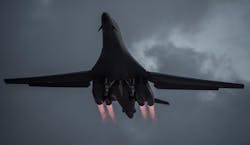Lockheed Martin to manufacture training system to help protect combat jet aircrews from radar-guided enemy missiles
HILL AIR FORCE BASE, Utah – Radar experts at Lockheed Martin Corp. will build a mobile advanced radar system to help pilots of the F-35 joint strike fighter learn to operate safely in hostile areas guarded by modern radar-guided surface-to-air missiles.
Officials of the Air Force Life Cycle Management Center at Hill Air Force Base, Utah, announced a $80.7 million order on Friday to the Lockheed Martin Missiles and Fire Control segment in Grand Prairie, Texas, to build five Advanced Radar Threat System - Variant 2 (ARTS-V2) systems, and for ARTS-V2 production option two.
The ARTS-V2 is a ruggedized mobile system designed to emulate radar-guided surface-to-air missile threats like the Russian-made SA-10, SA-12, and SA-20, which are built to strike at everything from low-flying drones and stealth cruise missiles to high-altitude reconnaissance airplanes and distant sensor platforms.
The SA-10 is designed to shoot down jet fighter aircraft like the F-35 and earlier-model combat jets. It has a range of nearly 50 miles and top speed approaching Mach 6. The SA-12 is for shooting down tactical ballistic missiles, and similar to the U.S. Patriot missile. The SA-20, meanwhile is an advanced development of the SA-12.
Lockheed Martin will build the ARTS-V2 to provide threat-representative radar tracking and reaction such as acquiring, tracking, and engaging several aircraft simultaneously with representative receiver, processor, and electronic counter-countermeasures.
The system will emulate advanced anti-aircraft missile radiated power, threat signals, antenna patterns, operational modes, and threat tactics, and can send real-time radar data to the Digital Integrated Air Defense System (DIADS)-controlled threat environment at the Range Control Center (RCC). ARTS-V2 will provide multi-spectral threat representation.
The ARTS-V2 is part of the overall Advanced Radar Threat System (ARTS) project to develop and field high-fidelity threat phased array radar for live, virtual, constructive aircrew training for anti-access and area-denial environments.
ARTS will provide the advanced capabilities necessary to train aircrews in the employment of F-35 aircraft against foreign fielded live double-digit surface-to-air missile threat systems. The program consists of the strategic long-range ARTS-V1 and the tactical short-range ARTS-V2 systems. The solicitation for the ARTS-V1 system was released in January.
On this order Lockheed Martin will do the work in Grand Prairie, Texas, and should be finished by October 2023. For more information contact Lockheed Martin Missiles and Fire Control online at www.lockheedmartin.com, or the Air Force Life Cycle Management Center-Hill Air Force Base at www.hill.af.mil.
About the Author
John Keller
Editor-in-Chief
John Keller is the Editor-in-Chief, Military & Aerospace Electronics Magazine--provides extensive coverage and analysis of enabling electronics and optoelectronic technologies in military, space and commercial aviation applications. John has been a member of the Military & Aerospace Electronics staff since 1989 and chief editor since 1995.
